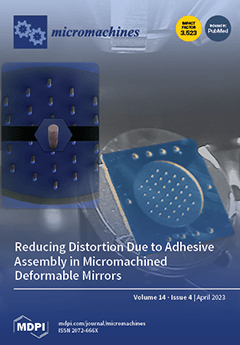The naphthalene derivative fluorescent probe F6 was synthesized and a 1 × 10
−3 mol/L solution of Al
3+ and other metals to be tested was prepared for the subsequent experiments. The Al
3+ fluorescence system of the naphthalene derivative fluorescent probe F6
[...] Read more.
The naphthalene derivative fluorescent probe F6 was synthesized and a 1 × 10
−3 mol/L solution of Al
3+ and other metals to be tested was prepared for the subsequent experiments. The Al
3+ fluorescence system of the naphthalene derivative fluorescent probe F6 was successfully constructed as demonstrated by fluorescence emission spectroscopy. The optimal time, temperature and pH of the reaction were investigated. The selectivity and anti-interference ability of the probe F6 for Al
3+ were investigated by fluorescence spectroscopy in a methanol solution. The experiments showed that the probe has high selectivity and anti-interference ability for Al
3+. The binding ratio of F6 to Al
3+ was 2:1, and the binding constant was calculated to be 1.598 × 10
5 M
−1. The possible mechanism of the binding of the two was speculated. Different concentrations of Al
3+ were added to Panax Quinquefolium and Paeoniae Radix Alba. The results showed that the recoveries of Al
3+ were 99.75–100.56% and 98.67–99.67%, respectively. The detection limit was 8.73 × 10
−8 mol/L. The experiments demonstrated that the formed fluorescence system can be successfully adapted for the determination of Al
3+ content in two Chinese herbal medicines, which has good practical application.
Full article






